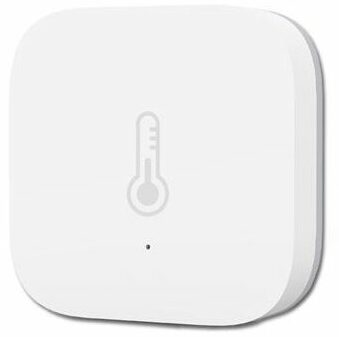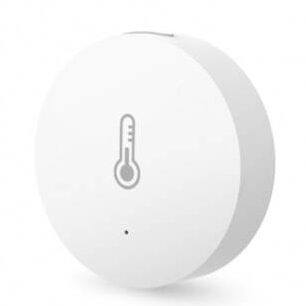Choosing the right Zigbee temperature and humidity sensor for Home Assistant can be a tricky task. After all, there are so many to pick from. To help you decide, I have put together a list of the best Zigbee temperature and humidity sensors currently available.

Why you need a Zigbee temperature and humidity sensor
Being able to measure the temperature and humidity is one of the most basic things you will want to do in a smart home. This metric can be useful in several ways: You can use the humidity to detect whether someone is in the bath or taking a shower, and thus keep the lights on even if the person is motionless. If you live in a dry area, you might turn on a humidifier when the humidity reaches a certain percentage, or you can use the temperature to adjust a thermostat. And some people, like me, just like seeing nice graphs on their Home Assistant dashboard.
As a low-power protocol, Zigbee sensors don't need large batteries and thus can be tiny and hidden away, out of sight. For example, a CR2032 button cell can power the Aqara Temperature and Humidity Sensor for up to two years and two CR2450 button cells can power the Aqara TVOC Air Quality Monitor, which has an E Ink screen.
There is one thing I recommend you look out for when browsing Zigbee temperature and humidity sensors: compatibility. After all, you don't want an individual hub for each vendor. The easiest way of making sure your Zigbee sensor is compatible with other Zigbee products, is by making sure it is Zigbee 3.0 certified. Unfortunately, there aren't many Zigbee 3.0 certified temperature and humidity sensors on the market yet, but this article will be updated once they make an appearance.
Aqara TVOC Air Quality Monitor with Zigbee 3.0
The Aqara TVOC Air Quality Monitor is my top pick for the best Zigbee temperature and humidity sensors for Home Assistant for several reasons:

- It uses the newer Zigbee 3.0 protocol, allowing for greater compatibility with third-party and DIY hubs such as Zigbee2MQTT and ZHA.
- It has a beautiful dot-matrix E Ink screen, allowing you to read the temperature without having to open the Home Assistant dashboard.
- Furthermore, it is magnetic, allowing you to place it almost anywhere.
- Uses the faster, stabler, and more energy-efficient Zigbee 3.0 protocol.
- Has a dot-matrix E Ink screen, making it legible under direct sunlight.
- Can be magnetically mounted to any surface.
- Powered by two CR2450 button cells which can last for up to a full year.
- 0.1° C temperature resolution, 1% humidity resolution, and 1ppb or 0.01 mg/m³ TVOC resolution.
As the name suggests, the Aqara TVOC Air Quality Monitor does more than just measure the temperature and relative humidity. It has an additional sensor capable of measuring the TVOC (total volatile organic compounds) in the air you are breathing. While the sensors probably aren't the most accurate and don't have a high resolution, they should give you an approximate idea of the air quality, temperature, and humidity.
It has been confirmed that the Aqara TVOC Air Quality Monitor works with both Zigbee2MQTT and ZHA.
Aqara Temperature and Humidity Sensor
The tiny and cheap Zigbee temperature and humidity sensor from Aqara is powered by a single CR2032 button cell, which can keep it running for up to two years. It operates at a temperature from -20 ℃ (-4℉) to 50 °C (122℉) with an accuracy of ±0.3℃ (±0.5°F), which is good for its price.
When bought directly from China, for example from a store on AliExpress, the Aqara Temperature and Humidity Sensor can be had for a very low price. These sensors are also reasonably good at measuring the humidity of a room with an accuracy of ±3%. With that accuracy, you can tell when the dehumidifier or humidifier needs to run. Though not advertised in the sensor's name, it can also measure atmospheric pressure.

One thing to note is that the Aqara Temperature and Humidity Sensor won't be continuously reporting to your Zigbee adapter. Instead, it will cleverly conserve power by only reporting once the value change reaches a certain threshold. I have found the Aqara Temperature and Humidity Sensor to react rather quickly whenever someone starts showering.
- Powered by a CR2032 button cell.
- Temperature detection range from -20° to 60° C (+/- 0.3° C).
- Humidity detection range from 0 to 100% RH (+/- 0.3%).
A downside of the Aqara Temperature and Humidity Sensor is that it isn't Zigbee 3.0 certified, nor does it make use of the updated protocol. There have been reports that Aqara sensors are problematic when mixed with routers from other vendors. For example, they seem to struggle to switch from the router they were first paired with. I have not had any issues with my sensors, but then again, my Zigbee network isn't the largest. Aqara will, at some point in the near future, update their sensor line-up to support Zigbee 3.0, so perhaps patience is the best option at this moment.
Is it a Xiaomi or Aqara sensor?
There is some confusion surrounding the Aqara brand. You will often see Aqara products described as Xiaomi Aqara. Before Lumi United, which is Aqara’s parent company, created its line of smart home products under the brand name Aqara, they were making devices for Xiaomi’s smart home brand called Mi and sometimes also Mijia.
Many of the Mijia and Aqara sensors look and behave similarly because they are essentially the same device in a slightly different case. Due to this relationship, you will often find Aqara devices described as Xiaomi Aqara devices.
The inferior Xiaomi Mijia Smart Temperature and Humidity Sensor
You will also be able to find a Xiaomi Mijia Smart Temperature and Humidity Sensor, which looks just like a round version of the Aqara equivalent. They even share the same icon. In comparison to the Aqara Temperature and Humidity Sensor, the Mijia sensor is missing one feature: It doesn't measure atmospheric pressure. Additionally, I prefer the square look of the Aqara sensor. For those two reasons, I recommend the Aqara Temperature and Humidity Sensor and not the Mijia equivalent.

Philips Hue motion sensors
Did you know that the Philips Hue motion sensor, which just as the previous two sensors also uses the Zigbee protocol, has a hidden temperature sensor? Well, now you do. And if you already have a few of these sensors placed around your home, you may as well use them to their maximum potential.
To be able to access the temperature in the Philips Hue motion sensor you will either need a Hue Labs Formula or the sensor has to be connected to a DIY Zigbee hub such as Zigbee2MQTT. Unfortunately, the hidden temperature sensor is all there is. The Philips Hue motion sensors do not measure humidity or atmospheric pressure.

Nice guide, thanks. But what about outdoor Zigbee temp sensors, can’t find any anywhere?
I couldn’t find anything else other than the pricey Philips Hue outdoor sensor. And it depends on what you mean by outdoor. This one has a IP54 rating (protected from limited dust ingress and protected from water spray from any direction).
https://www.amazon.com/Philips-Hue-Outdoor-Wireless-Required/dp/B07NDFQF2T/ref=as_li_ss_tl?ie=UTF8&linkCode=ll1&tag=liamalexcolmannet-20&linkId=706e1f011e5e816ae603a63ac15da99f&language=en_US
Thanks for the guide. From my experience the accuracy of the devices are all rather poor. Even the aqara ones have a variation of a few % in humidity (using the SHT31 chip).
That might not matter for a shower where you have extremes of humidity to measure, but if it were a kitchen extractor fan you might want it to turn on/off within a narrower relative range. In which case you would need regular and accurate monitoring.
You can get SHT35 based devices and connect them using the esp32 (the same esphone platform works for all the sht range). The accuracy is significantly better!
Thanks for the feedback!
TVOC Air Quality Monitor has a very poor accuracy. Not good enough for me. I sent it back. The Aqara software is partly Chinese.